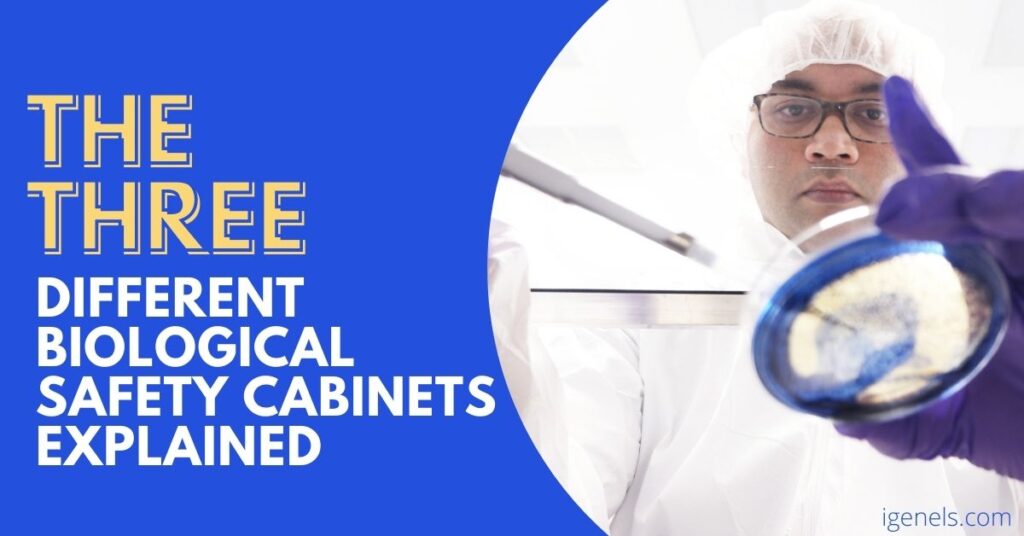A biological safety cabinet (BSC) is a major engineering control that filters both the inflow and exhaust air to protect employees from biohazardous or infectious agents and to help preserve quality control of the item being worked with. It’s also known as a tissue culture hood or a laminar flow hood.
These filtered cabinets are mainly intended to keep people safe from particles and aerosols. Through the exhaust HEPA filter, a portion of the air in most BSCs is recirculated back into the lab. This removes potentially pathogenic aerosols, animal dander, or both from the air, but does not lower chemical exposure.
All procedures should be carried out in such a way that the amount of aerosolized material produced is minimized and spills are avoided. Aerosol-generating operations include centrifugation, vortexing, sonication, and opening containers of infectious materials whose internal pressure differs from the ambient pressure. These processes should be carried out inside the BSC, or alternative safety precautions should be available.
Because both of these units of equipment work as enclosed workplaces, biosafety cabinet and laminar hoods may be mistaken as equal alternatives. However, a laminar hood protects only the sample, not the employees or the surroundings, whereas biosafety cabinets safeguard all three.

Explanation of the different Biosafety Levels
When working with biological agents that offer a minimum risk/threat to laboratory staff and the environment, Biosafety Level 1 is used. Working with these types of chemicals is usually done in open laboratory cabinets with no particular containment equipment.
Working with pathogenic or contagious organisms that provide a moderate risk is covered under Biosafety Level 2. Salmonellae, Hepatitis B virus, and Measles virus are just a few examples.
When working with indigenous or exotic agents that can cause serious or lethal disease by aerosol transmission, Biosafety Level 3 is used. Yellow Fever and Encephalitis are two examples.
When working with severely harmful, infectious, and life-threatening substances, Biosafety Level 4 is used. At all times, maximum containment and protection are essential. Ebola, the Lassa virus, and any other sample with uncertain toxicity and transmission hazards are examples.
Biosafety Cabinet Classes
Biosafety Cabinet Class I
Because “dirty” room air constantly enters the cabinet front and flows across the work surface, a Class I cabinet does not shield the goods from contamination. The Class I cabinet, as a partial containment device, is ideal for operations with low to moderate risk agents (biosafety levels 1,2, and 3) where confinement is required but not product protection. The HEPA filter in the Class I cabinet safeguards the environment by filtering air before it is vented, unlike traditional fume hoods. The steady circulation of air into the cabinet and away from the user allows for personnel protection.
The room air is pulled in through the entrance in the Class I BSC, which also allows the operator’s arm to enter during operation. The air inside the cabinet then sucks in any created aerosol particles and transports them away from the operator to the HEPA filter. Before being discharged into the environment, the air going out of the cabinet is disinfected by HEPA filters. The operator and the surroundings are thus protected from the aerosol, but the sample is not.
Biosafety Cabinet Class II
Because the makeup air is also HEPA-filtered, BSC-Class II cabinets provide both types of protection (for the samples and the environment). The operation of Class II cabinets is based on a fan installed on the top of the cabinet that draws a sterile air curtain over the workstation where biological items are handled. The air then passes through the HEPA filters after passing beneath the work station and back up to the top of the cabinet. Air is sucked into the front of the cabinet underneath the work surface to create the exhaust that leaves the facility.
The air sucked in works as a filter, preventing possibly polluted air from reaching the operator.
Class II BSCs are further divided into five types – Type A1, Type A2, Type B1, Type B2, and Type C1
Type A1
The type A1 cabinets have a minimum inflow velocity of 75 feet per minute, with the polluted air mixing with the inflow air directly above the work station. The mixed air is then forced through a duct system until it reaches the cabinet’s back. After that, the air may be recirculated after passing through the HEPA filters, or it may be expelled out of the cabinet, also after passing through a HEPA filter. Because working with hazardous chemical chemicals requires this type of cabinet, it is rarely used.
Type A2
A minimum inflow velocity of 100 feet per minute is required for type A2 cabinets. Type A2 BSC air enters the chamber through the front aperture in Class II, which protects the operator. The inflow air is mixed with the downflow air (from the top of the cabinet) and goes through the front intake grille before splitting over the workstation. Through the downflow HEPA filter, approximately 60% to 70% of the polluted air is recycled and sent back into the workstation in the chamber, while the remaining 30% to 40% is discharged through the exhaust HEPA filter. If dangerous, volatile chemicals are utilised in the cabinet as well as microbiological operations, exhaust must be vented into the atmosphere via the direct duct system. A2 type cabinets are also not widely used due to the risk of dangerous chemicals being released into the environment.
Type B1
Type B cabinets differ from Type A cabinets in that they manage the flow of hazardous vapours using a single-pass airflow system.
The polluted air is sent to the exhaust system in Type B1 cabinets, while the air between the operator and the workstation mixes with the inflow and is recirculated. To preserve the environment, the exhaust air dispersed from the facility should be filtered through HEPA filters.
These cabinets include a specialized duct system that permits contaminated air to be released outside of the facility. In Type B1 cabinets, 40% of the air is recirculated, while the other 60% is expelled out of the facility.
Type B2
The air is sucked in from the front entrance of a Type B2 BSC, just as it is in Type A cabinets, forming an air barrier that protects the operator. Air is also brought in through a hole in the top of the cabinet, which feeds the cabinet’s downflow of air. After passing through a HEPA filter, the air is evacuated completely through a dedicated duct system with an exhaust fan motor. As a result, the air leaving the facility is disinfected before being released into the atmosphere.
The benefit of this system is that poisonous vapours generated in the cabinet are removed without recirculating within the BSC. As a result, no air from inflow or downflow is recycled within the B2’s airflow system. These cabinets are ideal for jobs involving the discharge of chemical vapours since none of the air is recirculated. Type B2 cabinets, on the other hand, are costly, and their application is confined to toxicology laboratories where chemical protection is critical.
Type C1
The functioning mechanism of Type C1 cabinets is identical to that of Type B cabinets, however they are meant to lower operating expenses and increase laboratory flexibility. These cabinets operate on a single-pass airflow system, which involves mixing upflow air with downflow air split into columns for recirculation.
A second fan draws the air above the workstation, moving the contaminated air out through the exhaust system, which includes a HEPA filter.
The cabinets protect the environment, the operator, and the workstation or biological material in this manner. Type C cabinets differ from Type A cabinets in that they have a single-pass airflow system that does not circulate the air. These differ from Type B cabinets in that they don’t require a separate ducted exhaust system, may operate for longer periods of time to boost operator protection in the event of exhaust failure, and can even operate without exhaust.
Biosafety Cabinet Class III
All air that enters or leaves the facility passes through a HEPA filter in Class III cabinets, which are leak-tight, completely sealed but vented. Rubber gloves are linked to the system and are provided in the cabinets for use during cabinet operations. As a result, these cabinets are often known as ‘glove boxes.’ The cabinet even contains a transfer room where goods can be sterilized before leaving the glove box.
Despite the fact that the gloves limit the operator’s hand movement inside the cabinet, they prohibit direct contact between the operator and the samples. Double HEPA filters or HEPA filters in combination with incineration treat the exhaust air.
These cabinets are suitable for all four categories of biosafety (1, 2, 3, and 4). However, at Biosafety Level 4, these are the most necessary for the manipulation of biological materials. The majority of these cabinets are custom-built for specific laboratories, with lab equipment installed within the chamber. All of these structural and architectural aspects provide optimal protection against high-risk group 4 pathogenic organisms for the operator, the environment, and the sample.

